Whatever we call them, pots, tubs and containers have been a feature of gardens since people started gardening. Their versatility is perhaps their greatest asset, especially as gardens become smaller and there's more pressure about how to use the limited space.
Traditionally, container planting was associated with topiary — boxwood (
Buxus sp) and yew
(Taxus baccata) in particular — or included half cold-hardy plants for winter interest and half tender bedding to create a spectacular show of color and fragrance through summer.
Containers today are becoming intrinsic to the design rather just decorative additions. The main feature in this change is the method of planting within the containers and the way the containers are used within the overall garden design. We're now seeing studies in simplification: containers planted with a single species rather than the traditional mixing of species, and the grouping and repetition of similar containers to create impact within the overall garden design.
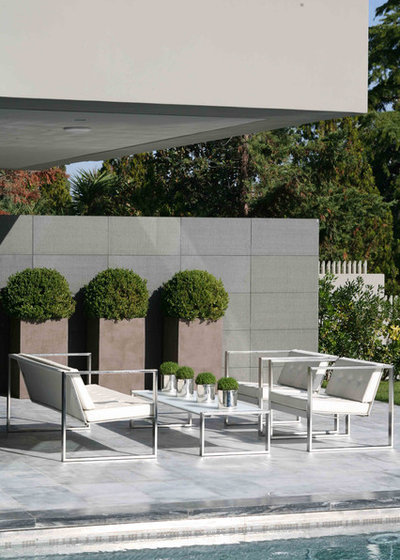 Complement Architecture With Containers
Complement Architecture With ContainersThis designer has used simply planted containers to strengthen the sharp lines of the clear overall design. Boxwood has been tightly clipped to create a strong outline against the wall behind.
The planters have been carefully chosen to fit the site, both in material and size, but are similar to the fabric of the garden structure, so they don't dominate the scheme. The formal clipped plantings in the main containers are nicely echoed in the small planters on the table.
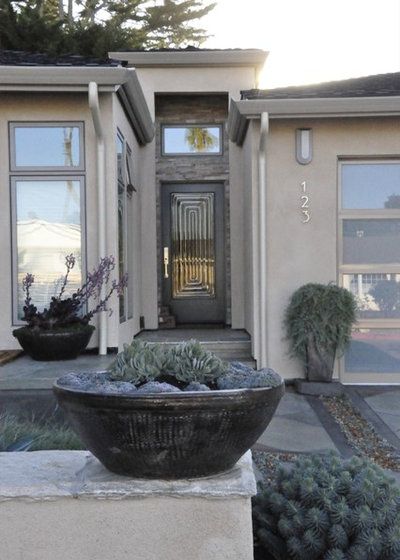
Jeffrey Gordon Smith Landscape Architecture
When containers are sited at the entrance of a building, the house becomes the context in which the container is seen. Some people may prefer large, blousy, colorful containers that contrast with the surroundings, but here the muted colors of both the containers and the plantings fit in with the neutral colors of the building and hardscape.
Though the succulent plantings are mixed within the containers, their similar tones easily blend together. The clever design trick here is the way the bowl planter is repeated closer to the house — linking the eye between the two bowls and playing with the perspective.
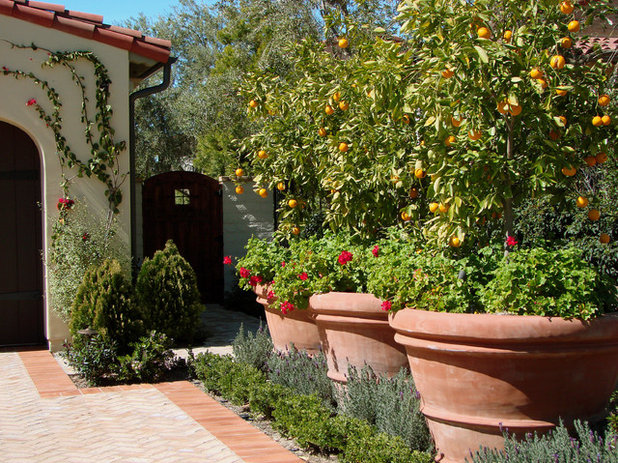
AMS Landscape Design Studios, Inc.
These large geranium-filled terra-cotta pots backed by overhanging citrus trees are more than just a garden feature; they're an integral part of the design — the terra-cotta pots reflect the tiles edging the paving. Finding an appropriate container and the right plants for the space is vital.
It can be tempting to fill spaces with many small planters and pots, filled with many different plants, but this can overwhelm a space.

Samarotto Design Group
Group Pots for ImpactThough not planted with the same species, these containers have been thoughtfully planted with foliage in similar tones. The differing foliage shape and texture provide visual diversity.
The grouping of containers creates a more integrated design than just dotting individual containers around the garden. Though single containers create great garden focal points, they can get lost in the greater scheme of a design. In smaller spaces, especially if containers are filled with similar plants, a grouping of containers can transform an area and create real drama.
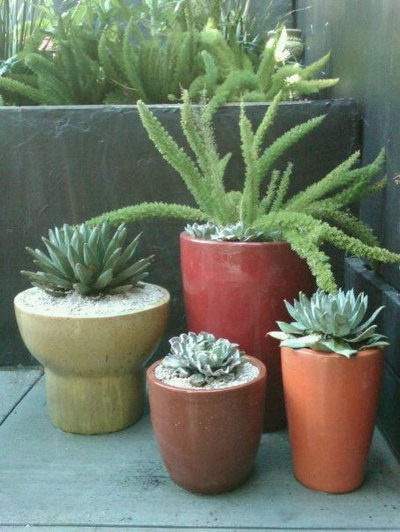
Daniel Nolan for Flora Grubb Gardens
This group of similarly shaped containers creates an amazing, coherent display that is interesting in its own right but also fits in as part of the overall garden layout.
Great care has been taken with the selection of the containers — their muted, warm colors are the perfect foil for the glaucous succulents and foxtail fern planted within them, but they also reflect the style of the garden.
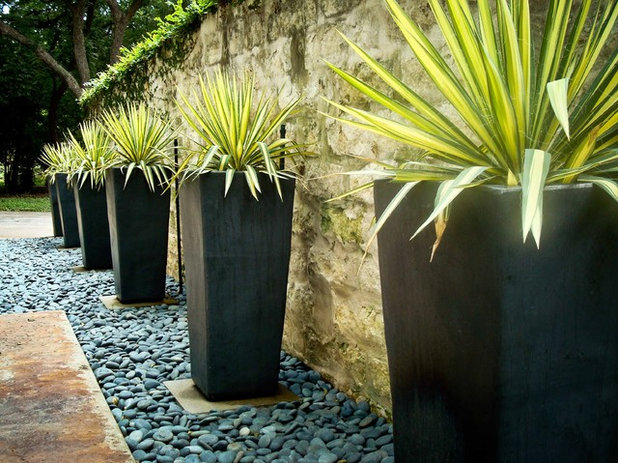
BLUE Renovation & Landscape
Add Perspective With RepetitionThis line of variegated yuccas planted in tall containers is more than just decoration — it employs a favorite feature of contemporary garden design, repetition. To achieve the best results, each container needs to mirror the next with an identical planting — the simpler, the better.
Repetition can help create perspective and harmony within a design, especially in smaller spaces where boundaries need to be defined.
A repetitive line of containers can make a garden appear longer or wider.
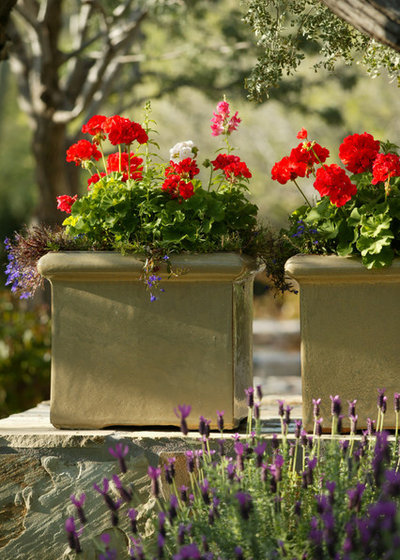
BERGHOFF DESIGN GROUP
Repetitive planters with identical plantings can also be used on a smaller scale. Care has been taken in matching containers here. The neutral color creates a wonderful foil for the brightly flowering geraniums.
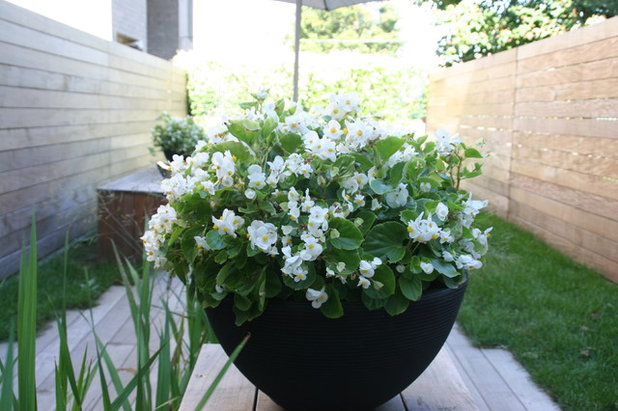
Little Miracles Designs
Think Outside EvergreensDesigners often use evergreens in containers — clipped, formal evergreens, such as boxwood and yew, or architectural plants like yucca or phormium. But a wide range of foliage and flowering plants can be valuable in establishing a clean, coherent theme in a contemporary garden design.
The simplicity of this dark bowl contrasts so beautifully with the stark white of the overplanted begonia.
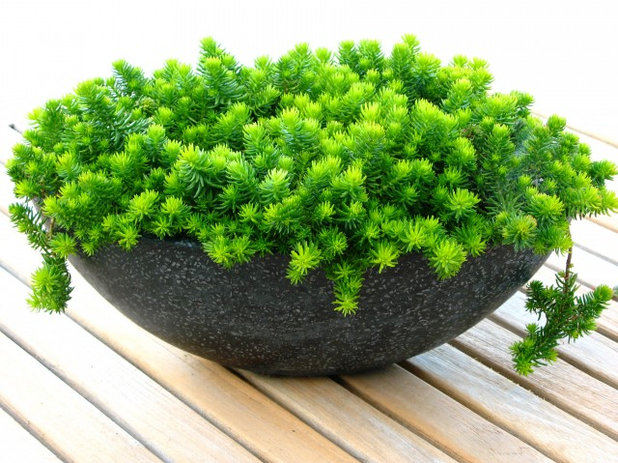
debora carl landscape design
This low bowl has been filled with the loose-growing
Sedum rupestre 'Angelina', making a great feature on its own. Repetition or a grouping of similar planters would only intensify the beauty of its foliage.
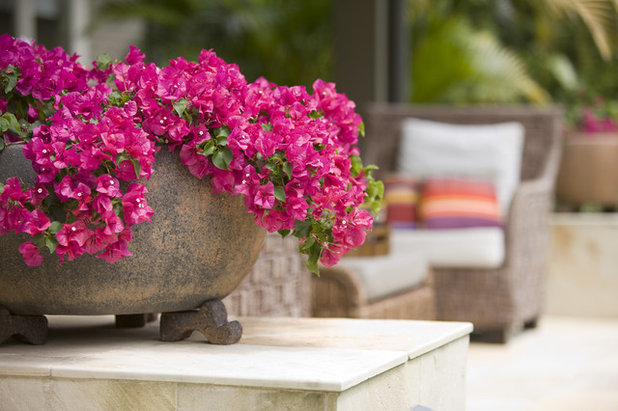
Secret Gardens
This beautiful, simple stoneware container raised high above a patio is planted with lovely bougainvillea. Its almost psychedelic color exemplifies perfectly how the simplest of container plantings can be the most effective, no matter the garden style.
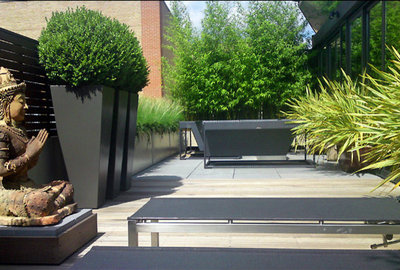
MyLandscapes
This contemporary London courtyard garden by Amir Schlezinger shows the main principles of containers as a central feature of modern garden design: setting and site, scale and grouping — but most important, the choice of plantings used in the containers.
Care has been taken here with the choice of planting within the containers; Schlezinger kept to a very restricted regime that doesn't overpower the contemporary design. The large evergreen boxwood balls topping the tall granite containers have been left loosely clipped to match the other informal plantings of bamboo and grasses. The containers have been repeated to give maximum impact and create perspective.
Rather than seeming imposed on the site, the carefully chosen planters have become part of the overall design, softening the hardness of the paving and fencing while being a feature in their own right.





